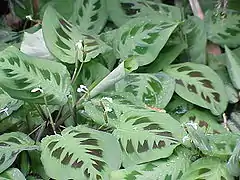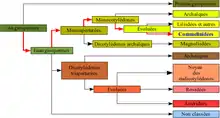Marantaceae
La famille des Marantaceae (Marantacées) regroupe des plantes monocotylédones ; elle comprend 400 espèces réparties en 30 genres.

| Règne | Plantae |
|---|---|
| Sous-règne | Tracheobionta |
| Division | Magnoliophyta |
| Classe | Liliopsida |
| Sous-classe | Zingiberidae |
| Ordre | Zingiberales |

Ce sont des plantes herbacées ou des lianes, rhizomateuses, parfois épiphytes, des régions subtropicales à tropicales.
Dans cette famille on peut citer les genres Goeppertia, Calathea et Maranta auxquels appartiennent des espèces cultivées comme plantes d'appartement pour leurs grandes feuilles panachées.

Dénomination
Étymologie
Le nom vient du genre Maranta donné en hommage au médecin et botaniste italien Bartolomeo Maranta (1500–1571), célèbre pour avoir écrit un livre sur l'intoxication[1].
Noms vernaculaires
Aux Antilles, en Amazonie et dans toute l'Amérique du Sud, l'espèce Goeppertia allouia est cultivée pour ses savoureux rhizomes. Cette plante est communément appelée "topinambur" ou "lerén" dans les pays hispanophones, "topinambour" en langue vernaculaire créole et "sweet corn root" dans les pays anglophones. Cependant, elle n'a rien à voir avec le Topinambour (Helianthus tuberosus). L'origine de la similitude du nom des deux plantes n'a pas encore été élucidée. Elle a un cycle végétatif long (environ 1 an), ce qui explique qu'elle ne soit pas cultivée à grande échelle. En Martinique et en Guadeloupe, ce "topinambour-pays" est très apprécié pour ses qualités gustatives.
Anatomie
L'inflorescence des Marantaceae est originale. Il s'agit d'un panicule d‘inflorescences spiciformes, c'est-à-dire un racème composé d'inflorescences elles-mêmes racémeuses (drépaniums) d’inflorescences spiciformes, qui sont elles-mêmes des panicules de diades (ou racème de drépaniums de diades)[2].
Liste des genres
Selon World Checklist of Selected Plant Families (WCSP) (16 février 2012)[3] :
- Afrocalathea K.Schum. (1902)
- Calathea G.Mey. (1818)
- Cominsia Hemsl. (1891)
- Ctenanthe Eichler (1884)
- Donax Lour. (1790)
- Goeppertia Nees (1831).
- Halopegia K.Schum (1902)
- Haumania J.Léonard (1949)
- Hylaeanthe A.M.E.Jonker & Jonker (1955)
- Hypselodelphys (K.Schum.) Milne-Redh. (1950)
- Indianthus Suksathan & Borchs. (2009)
- Ischnosiphon Körn. (1859)
- Koernickanthe L.Andersson (1981)
- Maranta Plum. ex L. (1753)
- Marantochloa Brongn. ex Gris (1860)
- Megaphrynium Milne-Redh. (1952)
- Monophyllanthe K.Schum. (1902)
- Monotagma K.Schum. (1901)
- Myrosma L.f. (1782)
- Phrynium Willd. (1797)
- Pleiostachya K.Schum. (1902)
- Sanblasia L.Andersson (1984)
- Saranthe (Regel & Körn.) Eichler (1884)
- Sarcophrynium K.Schum. (1902)
- Schumannianthus Gagnep. (1904)
- Stachyphrynium K.Schum. (1902)
- Stromanthe Sond. (1849)
- Thalia L. (1753)
- Thaumatococcus Benth. (1883)
- Trachyphrynium Benth. (1883)
Selon Angiosperm Phylogeny Website (21 mai 2010)[4] :
- Afrocalathea K.Schum.
- Ataenidia Gagnep.
- Calathea G.Mey.
- Cominsia Hemsl.
- Ctenanthe Eichler
- Donax Lour.
- Halopegia K.Schum.
- Haumania J.Leonard
- Hylaeanthe A.M.E.Jonker & Jonker
- Hypselodelphys (K.Schum.) Milne-Redh.
- Ischnosiphon Korn.
- Koernickanthe L.Andersson
- Maranta L.
- Marantochloa Brongn. ex Gris
- Megaphrynium Milne-Redh.
- Monophrynium K.Schum.
- Monophyllanthe K.Schum.
- Monotagma K.Schum.
- Myrosma L.f.
- Phacelophrynium K.Schum.
- Phrynium Willd.
- Pleiostachya K.Schum.
- Sanblasia L.Andersson
- Saranthe (Regel & Korn.) Eichler
- Sarcophrynium K.Schum.
- Schumannianthus Gagnep.
- Stachyphrynium K.Schum.
- Stromanthe Sond.
- Thalia L.
- Thaumatococcus Benth.
- Thymocarpus Nicolson, Steyerm. & Sivad.
- Trachyphrynium Benth.
Selon NCBI (22 avr. 2010)[5] :
- Afrocalathea
- Ataenidia
- Calathea
- Cominsia
- Ctenanthe
- Donax
- Halopegia
- Haumania
- Hylaeanthe
- Hypselodelphys
- Ischnosiphon
- Koernickanthe
- Maranta
- Marantochloa
- Megaphrynium
- Monophrynium
- Monotagma
- Myrosma
- Phacelophrynium
- Phrynium
- Pleiostachya
- Saranthe
- Sarcophrynium
- Schumannianthus
- Stachyphrynium
- Stromanthe
- Thalia
- Thaumatococcus
- Trachyphrynium
Selon DELTA Angio (22 avr. 2010)[6] :
- Afrocalathea
- Ataenidia
- Calathea
- Cominsia
- Ctenanthe
- Donax
- Halopegia
- Haumania
- Hylaeanthe
- Hypselodelphys
- Ischnosiphon
- Koernickanthe
- Maranta
- Marantochloa
- Megaphrynium
- Monophrynium
- Monophyllanthe
- Monotagma
- Myrosma
- Phacelophrynium
- Phrynium
- Pleiostachya
- Sanblasia
- Saranthe
- Sarcophrynium
- Schumannianthus
- Stachyphrynium
- Stromanthe
- Thalia
- Thaumatococcus
- Trachyphrynium
Liste des genres aux noms synonymes ou obsolètes et leur genre de référence
Selon [8]
- Actoplanes K.Schum. (1902) = genre Donax Lour. (1790)
- Allouya Plum. ex Aubl. (1775) = genre Maranta Plum. ex L. (1753)
- Arundastrum Rumph. ex Kuntze(1891), nom. illeg. = genre Donax Lour. (1790)
- Ataenidia Gagnep. (1908) = genre Marantochloa Brongn. ex Gris (1860)
- Bamburanta L.Linden (1900) = genre Trachyphrynium Benth. (1883)
- Calathea G.Mey. (1818) = plusieurs espèces ont été reclassées dans le genre Goeppertia Nees (1831)[9]
- genre Clinogyne Salisb. ex Benth. (1883) = genre Marantochloa Brongn. ex Gris (1860)
- Ctenophrynium K.Schum. (1902) = genre Saranthe (Regel & Körn.) Eichler (1884)
- Endocodon Raf. (1838) = Goeppertia Nees (1831)
- Hybophrynium K.Schum. (1892) = genre Trachyphrynium Benth. (1883)
- Hymenocharis Salisb. ex Kuntze (1891), nom. illeg. = genre Ischnosiphon Körn. (1859)
- Ilythuria Raf. (1838) = genre Donax Lour. (1790)
- Kerchovea Joriss. (1882) = genre Stromanthe Sond. (1849)
- Malacarya Raf. (1819) = genre Thalia L. (1753)
- Marantopsis Körn. (1862) = genre Stromanthe Sond. (1849)
- Monophrynium K.Schum. (1902) = genre Phrynium Willd. (1797)
- Monostiche Körn. (1858) = genre Goeppertia Nees (1831)
- Peronia F.Delaroche (1812) = genre Thalia L. (1753)
- Phacelophrynium K.Schum. (1902) = genre Phrynium Willd. (1797)
- Phyllodes Lour. (1790), nom. rej. = genre Stachyphrynium K.Schum. (1902)
- Psydaranta Neck. ex Raf. (1838) = genre Goeppertia Nees (1831)
- Spirostalis Raf. (1838) = genre Thalia L. (1753)
- Spirostylis Raf. (1838) = genre Thalia L. (1753)
- Thalianthus Klotzsch ex Körn. (1862) = genre Myrosma L.f. (1782)
- Thymocarpus' Nicolson, Steyerm. & Sivad. (1981) = Goeppertia Nees (1831)
- Zelmira Raf. (1838) = Goeppertia Nees (1831)
Notes et références
- (en) Maarten J M Christenhusz, Michael F Fay et Mark W. Chase, Plants of the World : An Illustrated Encyclopedia of Vascular Plants, Chicago, The University of Chicago Press, , 792 p. (ISBN 978-0-2265-2292-0), p. 190
- YVES SELL et GEORGES CREMERS, « Identification de l’unité de floraison des Marantacées », Beitr. Biol. Pflanzen, no 68, , p. 27-49 (lire en ligne)
- WCSP. World Checklist of Selected Plant Families. Facilitated by the Royal Botanic Gardens, Kew. Published on the Internet ; http://wcsp.science.kew.org/, consulté le 16 février 2012
- Stevens, P. F. (2001 onwards). Angiosperm Phylogeny Website. Version 14, July 2017 [and more or less continuously updated since]." will do. http://www.mobot.org/MOBOT/research/APweb/, consulté le 21 mai 2010
- NCBI, consulté le 22 avr. 2010
- DELTA Angio, consulté le 22 avr. 2010
- Integrated Taxonomic Information System (ITIS), www.itis.gov, CC0 https://doi.org/10.5066/F7KH0KBK, consulté le 22 avr. 2010
- (en-GB) « World Checklist of Selected Plant Families: Royal Botanic Gardens, Kew », sur wcsp.science.kew.org (consulté le )
- (en-GB) « World Checklist of Selected Plant Families: Royal Botanic Gardens, Kew », sur wcsp.science.kew.org (consulté le )
Liens externes
- (en) Référence Flora of North America : Marantaceae
- (en) Référence Flora of China : Marantaceae
- (en) Référence Madagascar Catalogue : Marantaceae
- (en) Référence Kew Garden World Checklist : Marantaceae
- (en) Référence Angiosperm Phylogeny Website : Marantaceae ()
- (en) Référence DELTA Angio : Marantaceae Petersen
- (en) Référence Catalogue of Life : Marantaceae (consulté le )
- (fr) Référence Tela Botanica (France métro) : Marantaceae
- (en) Référence Paleobiology Database : Marantaceae Brown
- (fr+en) Référence ITIS : Marantaceae
- (en) Référence NCBI : Marantaceae (taxons inclus)
- (en) Référence UICN : taxon Marantaceae (consulté le )
- (en) Référence GRIN : famille Marantaceae R. Br. (+liste des genres contenant des synonymes)